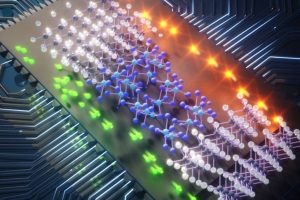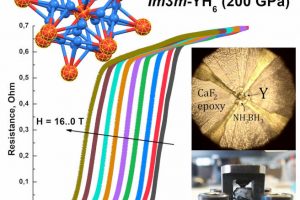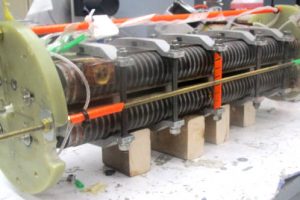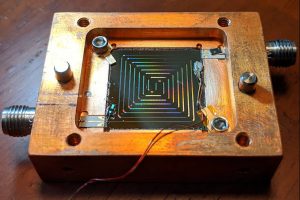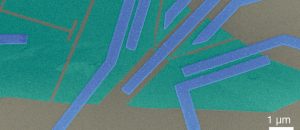
The proof-of-concept device is based on superconductivity, and combines a patterned single-layer graphene sheet (green) and metal (blue) electrodes on a silicon dioxide substrate (grey).
Superconductivity is caused by entangled pairs of electrons called Cooper pairs. These pairs enter through one electrode in the device and leave separately through two more (see photo and below), split by a temperature difference. “The resulting electrons remain entangled despite being separated for quite long distances,” said researcher Nikita Kirsanov of Aalto University in Finland.
“A Cooper pair splitting device such as this,” Kirsanov told Electronics Weekly, “provides a way of producing entangled pairs of electrons, potentially with very high rate. In such a device, the splitting can be driven by external voltage, however we show that it can also be caused by the temperature difference. With that, we now understand the processes behind the Cooper pair splitting much more accurately. Even in a device that does not employ heat as the primary driver of splitting, heating still occurs in accord with Joule’s law – knowing that this can, in turn, cause of the non-local thermoelectric effect, we can configure the device in the most optimal way significantly enhancing its performance. Moreover, sometimes heat can be more preferable as a driver of splitting, and we now know how to properly exploit it.”
As well as allowing this scientific discovery to be quantified, the experimental scheme could be a platform for further quantum thermodynamical experiments, according to Aalto University. Beyond this, developments of the techniques demonstrated could be of use in quantum cryptography and quantum computing.
Practical uses?
“In the future, we hope to convert the entangled electrons in to entangled photons but there is still a long way to go with this,” project head Professor Pertti Hakonen of Aalto University told Electronics Weekly. “Real applications of our device in quantum cryptography will become available first after making it as a fast source for entangled photons. At the moment, our technology is not sufficient for applications but hopefully in ten years we will be there.”
“Concerning quantum computing,” he continued, “our device provides just one block for generating and transferring certain states. It does not provide any concepts for quantum gates. Thus, these entangled electrons could be used as ‘flying qubits’ to connect various quantum devices together. Thereby, it can be employed as a means to enhance the overall computing power.”
How does it work?
How it all works, is described in the Nature Communications paper ‘Thermoelectric current in a graphene Cooper pair splitter‘, which is available in full to read on-line without payment.
 The platform (photo left) is constructed of superconducting aluminium conductors (blue stripes) and graphene (green).
The platform (photo left) is constructed of superconducting aluminium conductors (blue stripes) and graphene (green).
The key bits are two 150 x 200nm quantum dots, about 100nm apart, sadly hidden under the straight conductor coming out of the top of the photo, left of centre. This conductor is the superconducting Cooper pair injector.
Either side of that conductor are a couple more conductors each connected to a graphene (green) triangle whose tip act as a side gate to one of the two thin (just visible) graphene channel connections to the hidden dots. These gates allow independent control of dot resonance.
Moving out further, outside the gate control wires are conductors that connect to the far ends of the dot channels. These are the output leads, through which the entangled electrons leave, heading off to virtual-ground current pre-amplifiers.
According to the paper: “As the quantum dots in the device can be tuned individually, we are able to tune the device operation between elastic co-tunnelling and Cooper pair splitting regimes, thereby accomplishing direct control of two streams of entangled electrons.”
The experiment relies on temperature difference, with heat provided by current though a graphene resistor (thin graphene bridge between two larger patches of graphene (photo top left).
To measure the resulting thermal gradient are a pair of superconductor-graphene-superconductor Josephson junctions whose switching current reveals temperature. Each thermometer borrows one of the two output wires (remember they are superconducting), and adds a parallel wire just outside each of them (heading off in the opposite direction) as the second superconductor.
Aalto University worked with the Moscow Institute of Physics and Technology, Southern University of Science and Technology (Shenzhen) and the University of Chicago.
 Electronics Weekly Electronics Design & Components Tech News
Electronics Weekly Electronics Design & Components Tech News
